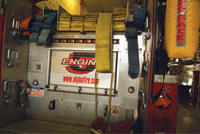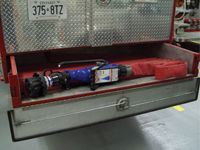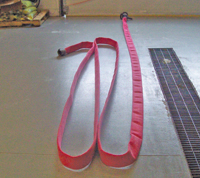
Features
Structural
Training
Back to Basics: Re-introducing the 2.5-inch hose
In the fire service we always look for ways to improve ourselves either through technology or our methods of operation. We have seen this with the introduction of the thermal imaging camera, 1.5-inch hose, two-inch hose, positive pressure ventilation fire attack and other advancements.
February 25, 2009
By Mark Van Der Feyst
 |
||
| Photo 1: Back of an engine company with 2.5-inch pre-connected handlines. Photo by Mike Gutschon |
||
 |
||
| Photo 2: Master-stream device supplied by a single 2.5-inch line. Easy deployment can be achieved by a single person. Photo by Mark van der Feyst |
||
 |
||
| Photo 3: Flaking the hoseline out perpendicular to the doorway allows firefighters to more easily advance the line. Photo by Mark van der Feyst |
In the fire service we always look for ways to improve ourselves either through technology or our methods of operation. We have seen this with the introduction of the thermal imaging camera, 1.5-inch hose, two-inch hose, positive pressure ventilation fire attack and other advancements.
As we go into the future, we sometimes need to bring the past with us. This is not to say that we must rely on tradition to fight fires, rather that we remember the foundational principles of fire fighting. We tend to forget the basics of fire fighting in the name of progress and technology. The basic concept of putting water on the fire to extinguish it is still the best and most effective way to fight fires. The old saying, big fire, big water, holds true to this day.
The 2.5-inch hoseline has become a forgotten tool. Sure, we have a pre-connected 2.5-inch line on our trucks and we also pack spare 2.5-inch line on the back of our engines for supply lines or ground deluges (see photo 1), or for our standpipe/fire department connections, but do we ever use the 2.5-inch hoseline to attack a fire? The answer is no, we don’t. In my 10 years of service, I can remember only one time when a 2.5-inch handline was pulled off as the first attack line for an interior attack. It was at an auto-body shop fire and the first arriving engine pulled of a 2.5-inch handline. That officer quickly recognized he had big fire that required big water. The other times a 2.5-inch line was used were for defensive operations involving a ground deluge.
So why don’t we use the 2.5-inch hoseline for offensive interior fire fighting? The answer usually has something to do with manpower shortages, the hose being too heavy to advance or fear of causing too much water damage. While these answers are true to some degree, we need to remember our building blocks of fire fighting, most importantly, big fire, big water.
The 2.5-inch handline can deliver the big water we need for a quick, aggressive initial interior attack. We need to deliver a big, quick knock-out punch when we have a fire, whether big or
small. Just as a boxer’s objective is to knock out his opponent with a one-punch hit, so too should our objective be to knock down the fire. One quick punch, delivered by a 2.5-inch nozzle will accomplish this.
I’m sure most of us have heard or seen the acronym ADULTS. This acronym spells out when we should use a 2.5-inch handline. The ADULTS principle is usually applied to high-rise operations and standpipe-equipped buildings.
- Advanced fire conditions upon arrival – this applies to when the first-arriving officer on scene witnesses an advanced fire or predicts that the fire will become advanced during the time it takes to set up operations.
- Defensive operations – the 2.5-inch line is perfect for setting up defensive operations with master-stream devices. (See photo 2.)
- Unable to determine the location or the extent of the fire – in high-rise and standpipe-equipped buildings, if no fire is showing, there could be a serious fast-moving fire deep within the building.
- Large, uncompartmentalized areas – these areas lead to rapid fire extension and growth. These types of fires need to be stopped right away. Using a 2.5-inch line will accomplish this.
- Tons of water – when you need lots of water, a 2.5-inch is the choice. It allows you to flow high volume with low pressure.
- Standpipe operations – these operations require 2.5-inch hose for the same reasons as above: high volume at low pressure.
This acronym is very accurate. The key is to know when to apply it. This takes practice and training. If we train with 2.5-inch handlines consistently then there will be no surprises when we have to pull a 2.5-inch line for the first time at an incident. How much water can a 2.5-inch nozzle deliver? Expect to flow between 100 and 500 gallons per minute depending upon the manufacturer. A great amount of water can be delivered using a 2.5-inch hoseline. This is what makes the 2.5-inch handline a versatile tool. It can be used for defensive operations and offensive operations. Larger hoses, such as three-inch inch, four-inch and so on, cannot be used for anything but defensive and supply operations.
Advancing a 2.5-inch line seems like an impossible task when you have limited manpower, but is it really? As mentioned, training on advancement will help in this area. The minimum number of firefighters advancing a line will be two to three. If you have the luxury of having four people advancing the line then you are ahead of the game. Large city departments will commit two engine companies to advance one 2.5-inch line. This is usually done in high-rise situations. When it comes to a typical residential structure fire, a small company of two to three people can advance a 2.5-inch line with ease. That is not to say that it will be easy; it will be hard work. Advance the line dry as far as you can, then charge it with water will help. This cuts down the work needed to advance the line. With the line dry, it is a good idea to flake the line outside in a pattern that allows you to advance with a bit of help from the hose. (See photo 3.) Flaking the hose perpendicular to the doorway of the structure allows the hose to be pulled in line with the advancing party. When you flake the hose parallel to the doorway of the structure, you have to pull the hose around a corner and this makes your job extremely difficult.
Usually we advance hoselines with water flowing at full pressure. With smaller lines such as one-inch and 1.5-inch, this can be accomplished with ease. When it comes to the 2.5-inch, this cannot be done because there is too much back pressure going against the advancing team. The key here is to close your nozzle halfway. This allows water flow to continue with enough protection being provided while allowing the team to advance the line. Less back pressure allows you to advance the line with two or three people. You need one person to help pull hose around corners and another to help back the nozzle man. Once you have advanced the line as far as you want, then re-open the nozzle completely to ensure full flow for fire knockdown. This technique takes practice to perfect.
We can also use 2.5-inch master streams for offensive operations. Different manufactures produce master-stream devices that are fed by a single 2.5-inch hose. In photo 2, we see an example of one such device. These master-stream devices deliver large volumes of water with quick, easy setup. These devices can be set up, with water flowing, and then left unmanned. There is a safety feature that turns off water flow when it senses any movement by the master-stream device. These devices are great for interior offensive operations. Large structures are the ideal setting for these guns. Any large fire inside a large structure (high rises, warehouses, mansions) a perfect setting for a master-stream device for interior attack to achieve a quick knockdown.
The 2.5-inch hoseline has been around since the beginning of the fire service and at one time was the only hose used to fight fires. With the introduction of smaller diameter hoses, we have forgotten about other weapons at our disposal, such as the 2.5-inch hoseline.
By bringing the past with us, we can achieve our goal of quick knockdown and increase our ability to become effective firefighters. This will only be accomplished by going back to basics.
Mark van der Feyst began his career in the fire service in 1998 with the Cranberry Township Volunteer Fire Company, Station 21, in Pennsylvania. He served as a firefighter and training officer for four years, then joined the Mississauga Fire & Emergency Services, where he served for three years as a firefighter and shift medical instructor. He is now the training division captain for the City of Woodstock Fire Department in Ontario.
Contact Mark at mvanderfeyst@gmail.com
Print this page